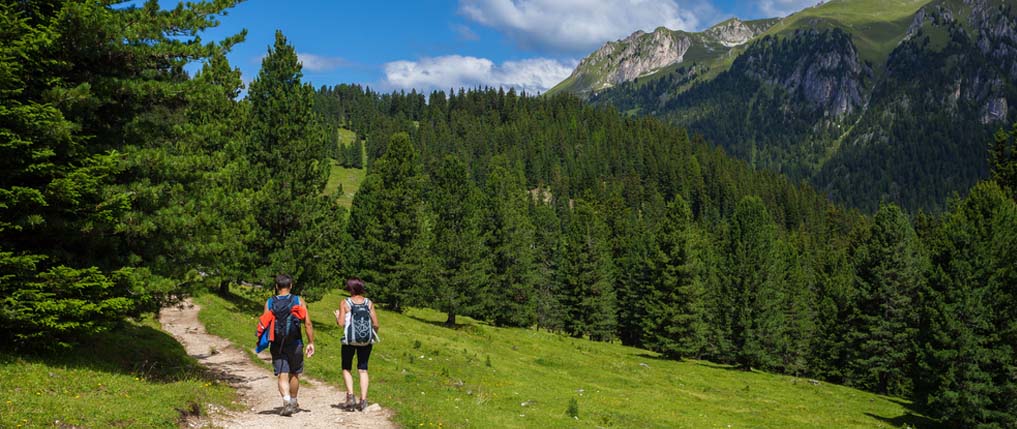Need-to-Know Trail Etiquette
July 3, 2021

Has hiking become your recent favorite activity? Getting outdoors in nature is beneficial for both your mental and physical well-being. However, like any new activity, there’s going to be a learning curve.
Even if you’ve familiarized yourself with all the hiking terms, there are still some ground rules that must be followed — especially when sharing the trail. Here are some of the unspoken rules and general guidance on basic trail etiquette.
Right of Way
Ever run into another hiker, mountain biker or even a horse and not know whether you or they have the right of way? Learn trail etiquette and know when to step aside.
Other Hikers
If you meet a fellow hiker on the trail, the hiker traveling uphill has the right of way. Uphill hikers usually have their heads down watching the steep path in front of them, drudging upward through rocks and roots and trying to keep a steady pace. Occasionally, you might get an out-of-breath uphill hiker who would prefer you to pass first. Another piece of trail etiquette, from one hiker to another, is to alert someone you are about to pass with a friendly greeting.
Mountain Bikers
The trial etiquette for passing other hikers is straightforward, but mountain bikers are a bit more nuanced. As a general rule, mountain bikers are expected to yield to hikers. However, that’s tricky to do at high speeds, so it’s also important for hikers to be aware of their surroundings and let a fast mountain biker pass. Most bikers will call out to make you aware they’re coming, too.
Equestrians
Horses are large animals so most reasonable hikers (and mountain bikers) know not to cut them off on the trail. Horses can be unpredictable, even under the control of their rider, so you want to give them the right of way at all times, just in case they get spooked or startled.
Hiking in a Group
Hiking solo is different than hiking with a group. While it’s nice to chat with fellow hikers and walk side-by-side, try to remember to fall in line single-file when the trail gets busier. This will allow other hikers and bikers to pass if needed. However, it is good etiquette for the single hiker to yield to larger groups of hikers so they can stick together.
Keep Noise to a Minimum
Learn to appreciate the sounds of nature and keep noise to a minimum. If you hike with a buddy and like to chat, keep your voices low and avoid disrupting others’ peaceful time on the trail. Additionally, turn your cell phone on silent or off completely. Lastly, remember that this isn’t the time to carry around a Bluetooth speaker on your backpack and stream your favorite playlists. Instead, use a single earbud and turn the volume low so you can hear others approaching.
Be Mindful of Your Phone

Speaking of your cell phone, if you do need to take a call, step to the side or off the trail and let others pass. Keep the call short, texting if you can to avoid making loud conversations. Also, try not to get in someone’s way as you try to capture the beauty of nature or take a selfie on the trail.
Don’t Blind Others with Your Headlamp
While this bit of trail etiquette only applies when night hiking, it’s a good one to remember. Keep your hiking headlamp at a lower setting, using the natural light of the moon, and avoid shining it directly in the eyes of a passing hiker. In fact, this bit of etiquette should be used at the campsite, too.
Pack Out All Trash
In your waterproof cooler backpack, pack a plastic bag or something to place trash in and carry home at the end of your hike. Don’t leave behind food wrappers or anything of that nature. Following the Leave No Trace principles, even biodegradable items like apple cores and banana peels should be packed out. Carry some doggie poop bags, too. Even better — pack out any trash, even if it’s not yours! Leave the trail better than you found it!
Don’t Feed the Wildlife
No matter how cute that chipmunk is, don’t feed it! Feeding wildlife of any kind is not helpful to the animal. While it seems kind, it is actually disrupting their natural foraging habits. And when wildlife become too accustomed to being fed, national and state parks must often resort to hazing to keep both humans and wildlife safe.
Leash Your Pet
Another way to be kind to wildlife is to keep your pet leashed at all times. Even a well-behaved dog could take off into the woods if something catches their interest. That’s why it’s always a good idea to keep them leashed and under your command.
Stay on the Trail
Another tip on trail etiquette centers on the trail itself. Most hikers know it’s good practice to stay on the designated trail to avoid getting lost. However, you should also stay on the trail to avoid widening the path. Cutting the corners of switchbacks and stepping around groups of people seem innocent, but it’s creating what is called social trails, which ultimately cause erosion and harm the overall sustainability. In other words, walk through those mud puddles, not around, to preserve the trail.
Do Your Business Far From the Trail
If you need to do your business or relieve yourself on the trail, practice Leave No Trace and go 200 feet from the trail. If you can’t do so without trampling native plants or potentially getting yourself injured, just find some privacy behind a tree or rock away from passing hikers. Of course, pack out any used toilet paper, too!

SIGN UP FOR EXCLUSIVE OFFERS
Sign up for our newsletter and get exclusive access to new product launches, special offers and much more.
RELATED BLOGS














